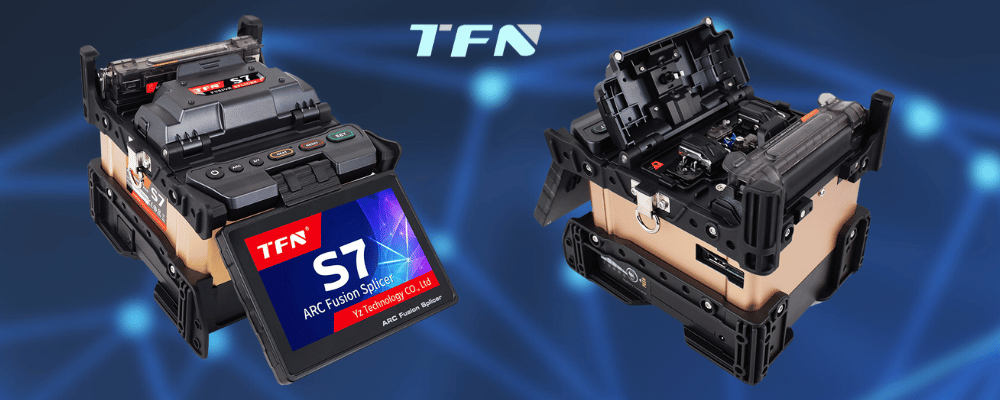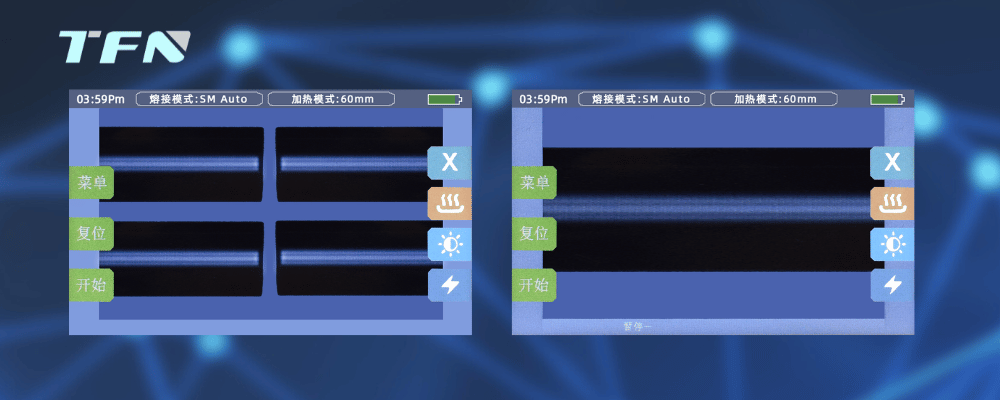What should you pay attention to when operating a fiber optic fusion splicer?
The working principle of the optical fiber fusion splicer is to use a high-voltage arc to melt the end faces of two optical fibers while using a high-precision propulsion motor to gently advance the two optical fibers into one to achieve coupling of the optical fiber mode fields. S7 is a welding machine equipped with 6 motors, which greatly improves the welding efficiency.
Optical fiber fusion splicers are mainly used in optical cable line engineering construction, optical fiber cable line maintenance and emergency repairs. They usually need to be used by professionals in a relatively clean and tidy environment to ensure the quality and stability of optical fiber connections. When operating the fiber fusion splicer, you need to pay attention to the following matters:

1. Environmental conditions: Ensure that the operating environment is clean and tidy, and try to avoid the impact of dust, moisture, etc. on optical fiber splicing.
2. Safe operation: Operators should wear protective glasses and gloves to avoid being harmed by light and heat that may be generated during optical fiber splicing.
3. Optical fiber preparation: Before fiber splicing, three steps are required to prepare the optical fiber:
①Coating peeling: peel off the sheath to leave at least 50mm of coating (the same for loose-buffered optical fiber and tight-buffered optical fiber). Use fiber stripping pliers to remove the coating layer, the length is 30~40mm.
②Clean the optical fiber with tissue paper dipped in alcohol
③For fiber cutting, it is best to use high-precision cutting tools to cut the fiber. In order to ensure the quality of splicing, a high-precision cutting knife should be used for cutting, such as the A9 series fiber optic cutting knife, and the length of the fiber cutting should be strictly controlled.
Note: Use more than 99% pure alcohol to clean the stripped optical fiber. Do not let the cut optical fiber end touch any object or be contaminated.
The TFN S7 welding machine is fully equipped, from cutting, cleaning to welding, ensuring the quality and efficiency of welding.

4. Equipment cleaning and inspection: Use a cotton swab dipped in more than 99% pure alcohol to clean the bottom of the V-shaped groove, use a clean cotton swab to wipe off excess alcohol, and use a section of prepared optical fiber to clean foreign matter in the groove. Before operating, check whether all parts of the equipment are normal and ensure that the equipment is in good condition.
5. Set parameters: Set the parameters of the fusion splicer according to the type and diameter of the optical fiber to be connected, including splicing time, splicing current, splicing temperature, etc. The S7 fusion splicer is equipped with a 6-motor alignment system that accurately identifies fiber types and automatically selects the matching splicing mode. Splicing only takes 6 seconds.
6. Operation steps:
①Place the optical fiber: Normally, the cross-section of the optical fiber is about 2-3mm away from the midpoint of the connecting line of the two electrode rods.
②Start welding: Place the optical fiber at both ends, conduct automatic discharge test of the electrode, and wait until the execution is completed.
③Welding completed: Take out the fused optical fiber, place the heat shrink tube in the middle of the heating furnace, move the optical fiber so that the welding point is at the center of the heat shrink tube, cover the heating furnace cover and start heating.
④Quality inspection: After the welding is completed, inspect the quality of the optical fiber connection, including checking the damage of the connection points, tensile testing, etc.

7. Recording and maintenance: Record the parameters and results of each welding, and perform regular maintenance and upkeep on the welding machine to ensure long-term stable operation of the equipment.
Operators often encounter some problems when operating fiber fusion splicers. We have compiled some common problems and put forward corresponding solutions, hoping to be of some help to you.
Error info |
Reason |
Solution |
Left/right fiber placement |
The fiber end face exceeds the electrode center line. |
Press RESET and re-insert the optical fiber so that the end face of the optical fiber is between the center line of the electrode and the edge of the V-shaped groove. |
Propulsion motor stroke exceeds |
The fiber is not correctly placed at the bottom of the V-groove, causing the fiber |
After pressing RESET, place the optical fiber correctly. |
Left and right fiber end faces contact |
[Overlap amount] is set too small |
Adjust the [Overlap Amount] parameter |
The motor is not calibrated |
Perform [Motor Calibration] maintenance |
|
Fiber positioning failed |
Fiber is incorrectly placed at the bottom of the V-groov |
Press the RESET button and reposition the fiber so that it is correctly placed at the bottom of the V-groove |
The optical fiber is not placed within the camera's viewing angle. |
Confirm that the stripped fiber is placed in the position of the fiber cleaver |
|
The cutting length (bare fiber part) is too short |
Check cutting length |
|
The angle between the end faces is too large |
Fiber end face quality is too poor |
Re-prepare the fiber. If the problem persists, check if the cleaver blade is worn. If worn, rotate the blade to a new side. |
[Cutting angle limit] is too small |
Increase [Cutting Angle Limit] to a suitable value (standard 2.0°) |
|
The fiber core angle is too large |
[Core angle limit] is too small |
Increase [Cutting Angle Limit] to a suitable value (standard 1.0°) |
There is dust or dirt in the V-groove or optical fiber ferrule |
Clean the V-groove and optical fiber hammer and prepare the optical fiber again to place the optical fiber. |
|
Optical fiber is too dirty |
There is dust or dirt on the surface of the optical fiber |
Re-prepare the fiber |
There is dirt on the lens |
After cleaning the lens, perform [Dust Check] and clean the objective lens if there is dirt. |
|
[Cleaning discharge time] is too short |
Set [Cleaning Discharge Time] to 180ms |
In short, only by strictly following the operating procedures and precautions when using the S7 optical fiber fusion splicer can we ensure the quality of splicing and improve work efficiency. Fiber fusion splicing technology is an indispensable part of the modern high-tech field. For those engaged in the fields of optical fiber communications and optical fiber sensors, it is crucial to master its operating technology.
If you are interested in the TFN S7 fusion splicer, please contact the TFN sales team:
Email:info@tfngj.com
WhatsApp: +86-18765219251
In addition, please click on the following social media links to watch the TFN fiber optic fusion splicer splicing and heating video:
Facebook: https://www.facebook.com/61559730163985/videos/1143193310072764
YouTube: https://youtu.be/1f9kkPGL6vg?si=0CPG0bgOrhfn4nTp
